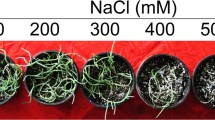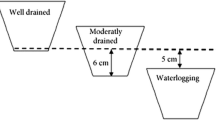Abstract
Reaumuria vermiculata (L.), a perennial dwarf shrub in the family of Tamaricaceae, is a salt-secreting xero-halophyte found widely in arid areas of Tunisia. In the present study, physiological attributes of R. vermiculata were investigated under salt stress. Four-month-old plants were subjected to various salinity levels (0, 100, 200, 300, 400 or 600 mM NaCl) for 30 days under greenhouse conditions. Results showed that plants grew optimally when treated with standard nutrient solution without NaCl supply. However, increasing osmolality of nutrient solutions caused a significant reduction in biomass production and relative growth rate. This reduction was more pronounced in roots than in shoots. In addition, this species was able to maintain its shoot water content at 30% of the control even when subjected to the highest salt level, whereas root water content seemed to be unaffected by salt. Shoot water potential declined significantly as osmotic potential of watering solutions was lowered and the more negative values were reached at 600 mM NaCl (−3.4 MPa). Concentrations of Na+ and Cl− in the shoots of R. vermiculata were markedly increased with increasing osmolality of nutrient solutions, whereas concentration of K+ was not affected by NaCl supply. Salt excretion is an efficient mechanism of Na+ exclusion from the shoots of this species exhibiting high K+/Na+ selectivity ratio over a wide range of NaCl salinity. Proline accumulation in shoots was significantly increased with increase in salt level and may play a role in osmoregulation.








Similar content being viewed by others
References
Arnon DI, Hoagland DR (1940) Crop production in artificial solutions and in soils with special reference to factors affecting yields and absorption of inorganic nutrient. Soil Sci 50:463–484
Ashraf M, Foolad MR (2007) Roles of glycine betaine and proline in improving plant abiotic stress resistance. Environ Exp Bot 59:206–216
Ashraf M, Harris PJC (2004) Potential biochemical indicators of salinity tolerance in plants. Plant Sci 166:3–16
Barhoumi Z, Djebali W, Smaoui A, Chaïbi W, Abdelly C (2007) Contribution of NaCl excretion to salt resistance of Aeluropus littoralis (Willd) Parl. J Plant Physiol 164:842–850
Bates S, Waldren RP, Teare ID (1973) Rapid determination of the free proline in water stress studies. Plant Soil 39:205–208
Boyer JS (1982) Plant productivity and environment. Science 218:443–448
Debez A, Ben Hamed K, Grignon C, Abdelly C (2004) Salinity effects on germination, growth and seed production of the halophyte Cakile maritima. Plant Soil 262:179–189
Flowers TJ, Hajibagheri MA, Yeo AR (1991) Ion accumulation in the cell walls of rice plants growing under saline condition: evidence for the Oertli hypothesis. Plant Cell Environ 14:319–325
Glenn EP, Brown JJ (1998) Effects of soil salt levels on the growth and water use efficiency of Atriplex canescens (Chenopodiacecae) varieties in drying soil. Am J Bot 85:10–16
Gorai M, Neffati M (2007) Germination responses of Reaumuria vermiculata to salinity and temperature. Ann Appl Biol 151:53–59
Gorai M, Ennajeh M, Khemira H, Neffati M (2010a) Influence of NaCl-salinity on growth, photosynthesis, water relations and solute accumulation in Phragmites australis. Acta Physiol Plant. doi:10.1007/s11738-010-0628-1
Gorai M, Ennajeh M, Khemira H, Neffati M (2010b) Combined effect of NaCl-salinity and hypoxia on growth, photosynthesis, water relations and solute accumulation in Phragmites australis plants. Flora 205:462–470
Gorham J, Bristol A, Yopung EM, Wyn Jones RG, Kashour G (1990) Salt tolerance in the Triticeae: K/Na discrimination in barley. J Exp Bot 41:1095–1101
Greenway H, Munns R (1980) Mechanisms of salt tolerance in nonhalophytes. Ann Rev Plant Physiol 31:149–190
Hasegawa PM, Bressan RA, Zhu JK, Bohnert HJ (2000) Plant cellular and molecular responses to high salinity. Ann Rev Plant Physiol Plant Mol Biol 51:463–499
Hewitt EJ (1966) Sand and water culture methods used in the study of plant nutrition. Commonw Bureau Horticult Tech Com 22:431–446
Hogarth PJ (1999) The Biology of Mangroves. Oxford University Press, NewYork
Hunt R (1990) Basic growth analysis. Plant growth analysis for beginners. Unwin Hyman, London
Inskeep WP, Bloom PR (1985) Extinction coefficients of chlorophyll a and b in N,N-dimethylformamide and 80% acetone. Plant Physiol 77:483–485
Jacobson L (1951) Maintenance of iron supply in nutrient solutions by a single addition of ferric-potassium-ethylene-diamine-tetracetate. Plant Physiol 26:411–413
Jaleel CA, Gopi R, Sankar B, Manivannan P, Kishorekumar A, Sridharan R, Panneerselvam R (2007) Alterations in germination, seedling vigour, lipid peroxidation and proline metabolism in Catharanthus roseus seedlings under salt stress. S Afr J Bot 73:190–195
Koyro HW (2006) Effect of salinity on growth, photosynthesis, water relations and solute composition of the potential cash crop halophyte Plantago coronopus (L.). Environ Exp Bot 56:136–146
Le Houérou HN (1993) Salt tolerant plants for the arid regions of the Mediterranean isoclimatic zone. In: Lieth H, Al-Masoom A (eds) Towards the rational use of high salinity tolerant plants. Kluwer, Dordrecht, pp 403–422
Le Houérou HN (1995) Forage halophytes in the Mediterranean basin. In: Choukr-Allah R, Malcom CV, Hamdy A (eds) Halophytes and biosaline agriculture. Marcel Dekker, New York, pp 115–135
Liu YB, Wang G, Liu J, Zhao X, Tan HJ, Li XR (2007) Anatomical, morphological and metabolic acclimation in the resurrection plant Reaumuria soongorica during dehydration and rehydration. J Arid Environ 70:183–194
M’rah S, Ouerghi Z, Berthomieu C, Havaux M, Jungas C, Hajji M, Grignon C, Lachaâl M (2006) Effects of NaCl on the growth, ion accumulation and photosynthetic parameters of Thellungiella halophila. J Plant Physiol 163:1022–1031
Maathuis FJM, Amtmann A (1999) K+ Nutrition toxicity: the basis of cellular K+/Na+ ratios. Ann Bot 84:112–133
Mansour MMF, Salama KHA (2004) Cellular basis of salinity tolerance in plants. Environ Exp Bot 52:113–122
Marschner H (1995) Mineral nutrition of higher plants. Academic Press, London
Munns R (2002) Comparative physiology of salt and water stress. Plant Cell Environ 25:239–250
Munns R, Passioura JB (1984) Hydraulic resistance of plants. III. Effects of NaCl in barley and lupin. Aust J Plant Physiol 11:351–359
Naidoo G, Somaru R, Achar P (2008) Morphological and physiological responses of the halophyte, Odyssea paucinervis (Staph) (Poaceae), to salinity. Flora 203:437–447
Oertli JJ (1968) Extra cellular salt accumulation, a possible mechanism of salt injury in plants. Agrochimica 12:461–469
Owens S (2001) Salt of the earth. Genetic engineering may help to reclaim agricultural land lost due to salinisation. EMBO Rep 2:877–879
Parida AK, Das AB (2005) Salt tolerance and salinity effects on plants: a review. Ecotox Environ Safe 60:324–349
Pottier-Alapetite G (1979) Flore de la Tunisie. Angiosperme-Dicotylédones. Vol. I: Apétales-Dialypétales. Ministère de l’Enseignement Supérieur et de la Recherche Scientifique et le Ministère de l’Agriculture, Tunis
Ramadan T (1998) Ecophysiology of salt excretion in the xero-halophyte Reaumuria hirtella. New Phytol 139:273–281
Ramadan T (2001) Dynamics of salt secretion by Sporobolus spicatus (Vahl) Kunth from sites of differing salinity. Ann Bot 87:259–266
Robyt JF, White BJ (1987) Biochemical techniques—theory and practice. Books/Cole Publishing Company, Monterey, pp 267–275
Rodriguez-Navarro A (2000) Potassium transport in fungi and plants. Biochem Biophys Acta 1469:1–30
Saadallah K, Drevon JJ, Abdelly C (2001) Nodulation et croissance nodulaire chez le haricot (Phaseolus vulgaris) sous contrainte saline. Agronomie 21:627–634
Scholander PF, Hammel HT, Bradstreet ED, Henningsen EA (1965) Sap pressure in vascular plants. Science 148:339–346
Shachtman D, Munns R, White Cross MI (1991) Variation in sodium exclusion and salt tolerance in Triticum tauschii. Crop Sci 31:992–997
Singh AK, Dubey RS (1995) Changes in chlorophyll a and b contents and activities of photosystems I and II in rice seedlings induced by NaCl. Photosynthetica 31:489–499
Speer M, Kaiser WM (1991) Ion relations of symplastic and apoplastic space in leaves from Spinacia oloraceae L. and Pisum sativum L. under salinity. Plant Physiol 97:990–997
SPSS (2002) SPSS 11.5 for Windows Update. SPSS Inc, Chicago
Sultana N, Ikeda T, Itoh R (1999) Effect of NaCl salinity on photosynthesis and dry matter accumulation in developing rice grains. Environ Exp Bot 42:211–220
Tester M, Davenport R (2003) Na+ tolerance and Na+ transport in higher plants. Ann Bot 91:503–527
Wolf O, Munns R, Tounet ML, Jeschke WD (1991) The role of the stem in the partitioning of Na+ and K+ in salt-treated barley. J Exp Bot 42:697–704
Yeo AR (1998) Molecular biology of salt tolerance in the context of whole-plant physiology. J Exp Bot 49:915–929
Zhu JK (2001) Plant salt tolerance. Trends Plant Sci 6:66–71
Author information
Authors and Affiliations
Corresponding author
Additional information
Communicated by R. Aroca.
Rights and permissions
About this article
Cite this article
Gorai, M., Neffati, M. Osmotic adjustment, water relations and growth attributes of the xero-halophyte Reaumuria vermiculata L. (Tamaricaceae) in response to salt stress. Acta Physiol Plant 33, 1425–1433 (2011). https://doi.org/10.1007/s11738-010-0677-5
Received:
Revised:
Accepted:
Published:
Issue Date:
DOI: https://doi.org/10.1007/s11738-010-0677-5




